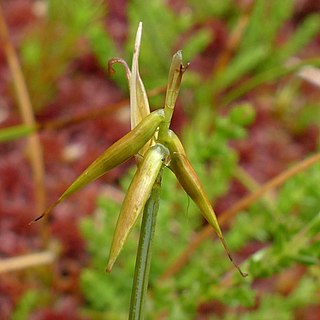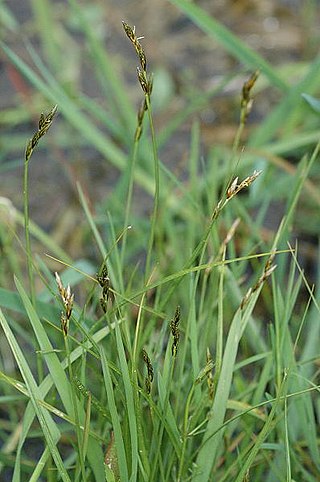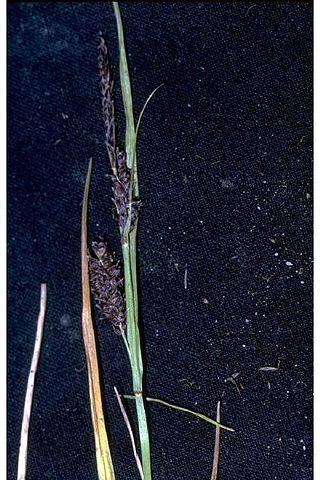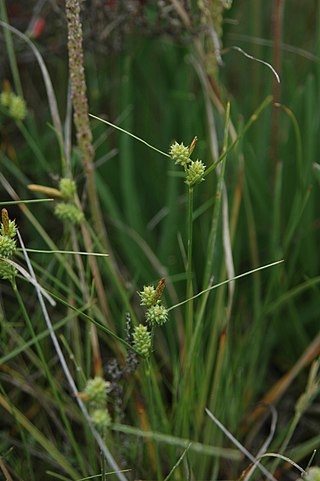
The Cyperaceae are a family of graminoid (grass-like), monocotyledonous flowering plants known as sedges. The family is large, with some 5,500 known species described in about 90 genera, the largest being the "true sedges" genus Carex with over 2,000 species.
NVC community W3 is one of the woodland communities in the British National Vegetation Classification system.

Carex limosa is a species of sedge known as bog-sedge, mud sedge, and shore sedge.

Carex pauciflora, the few-flowered sedge, is a perennial species of sedge in the family Cyperaceae native to bogs and fens in cool temperate, subarctic, and mountainous regions of the Northern Hemisphere. The specific epithet pauciflora refers to the Latin term for 'few flowered'.

Carex pendula is a large sedge of the genus Carex. It occurs in woodland, scrubland, hedges and beside streams, preferring damp, heavy clay soils. It is sometimes grown as a garden plant because of its distinctive appearance.

Carex buxbaumii is a species of sedge known as Buxbaum's sedge or club sedge. It is native to much of the northern Northern Hemisphere, from Alaska to Greenland to Eurasia, and including most of Canada and the United States. It grows in wet habitat, such as marshes and fens. This sedge grows in clumps from long rhizomes. The stems are 75–100 cm (30–39 in) in maximum height. The leaves are narrow and small. The inflorescence has a bract which is sometimes longer than the spikes. The fruits have dark-colored bracts and a sac called a perigynium or utricle which is gray-green and rough in texture.

Carex diandra is a species of sedge known by the common names lesser tussock-sedge and lesser panicled sedge.

Carex leporina is a species of sedge known in the British Isles as oval sedge and in North America as eggbract sedge. It is native to Eurasia and eastern and western North America, where it grows in seasonally wet habitat, such as meadows and fields. This sedge produces many thin stems and narrow leaves. The inflorescence is an open cluster of several flower spikes. The pistillate flower has a reddish or brownish bract with a gold center and white tip.

Carex vulpinoidea is a species of sedge known as fox sedge and American fox-sedge. It is native to North America, including most of Canada, the Dominican Republic, the United States and parts of Mexico. It is known in Europe and New Zealand as an introduced species. The sedge lives in wet and seasonally wet habitat, and grows easily as a roadside weed. It produces clumps of stems up to a meter tall. The inflorescence is a dense, tangled cluster of many flower spikes up to about 10 cm (3.9 in) long. Tolerates fluctuating water levels and periods of drying.

Carex disticha is a Eurasian species of sedge known as the brown sedge or, in North America, tworank sedge.

Carex acutiformis, the lesser pond-sedge, is a species of sedge.

Carex binervis, the green-ribbed sedge, is a European species of sedge with an Atlantic distribution. It is found from Fennoscandia to the Iberian Peninsula, and occurs in heaths, moorland and other damp, acidic environments. It typically grows to a height of 15–120 cm (6–50 in), and has inflorescences comprising one male and several female spikes, each up to 45 mm (1.8 in) long. The utricles have two conspicuous green veins, which give rise to both the scientific name and the common name of the species. In the vegetative state, it closely resembles C. bigelowii, a species that usually grows at higher altitude. C. binervis was first described by James Edward Smith in 1800, and is classified in Carex sect. Spirostachyae; several hybrids with other Carex species are known.

Carex pilulifera, the pill sedge, is a European species of sedge found in acid heaths, woods and grassland from Macaronesia to Scandinavia. It grows up to 30 cm (12 in) tall, with 2–4 female spikes and 1 male spike in an inflorescence. These stalks bend as the seeds ripen, and the seeds are collected and dispersed by ants of the species Myrmica ruginodis.
Carex laevigata, the smooth-stalked sedge, is a species of sedge. It lives in moist, shady environment in the lowlands of Western and Central Europe, particularly in alder–ash woodland. It is distinguished from similar species, such as C. binervis and C. distans by the presence of tiny red dots on the utricles. Carex laevigata was first described by James Edward Smith in 1800, in a paper in the journal Transactions of the Linnean Society of London.

Carex bigelowii is a species of sedge known by the common names Bigelow's sedge, Gwanmo sedge, and stiff sedge. It has an Arctic–alpine distribution in Eurasia and North America, and grows up to 50 centimetres (20 in) tall in a variety of habitats.

Carex saxatilis is a species of sedge known by the common names rock sedge and russet sedge.

Carex divisa is a species of sedge known by the common names divided sedge and separated sedge. It is native to Europe, Asia, and North Africa, and considered naturalized in Australia, New Zealand, and scattered locations in North America.

Carex extensa is a species of sedge known by the common name long-bracted sedge. It is native to Europe, North Africa, and the Middle East.

Carex paniculata, the greater tussock-sedge, is a species of flowering plant in the sedge family, Cyperaceae. It grows 1.5 metres high and can be found in most of Europe, Northwest Asia and North America.

Carex distans, commonly known as distant sedge, is a plant species in the sedge family, Cyperaceae. It is native to Europe and North Africa. It is part of a complex of similar species that occur across Eurasia. Its relatives include Carex diluta of central Asia, which has also introduced to North America in Montana. C. distans has been introduced to US states including Maryland and Pennsylvania. More recently, it was found in Oregon. There is a report from Victoria, Australia as well.


















